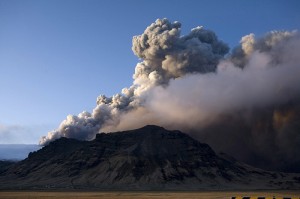 There is considerable debate on the role that humans play in changing global climate through both the burning of fossil fuels and the release of chlorofluorocarbon (CFC) gases. Some argue that human interaction poses less of a threat to our atmosphere than do natural processes. Whatever the source, it is apparent that compositional changes in the earth’s atmosphere generate two principal climatic effects:
There is considerable debate on the role that humans play in changing global climate through both the burning of fossil fuels and the release of chlorofluorocarbon (CFC) gases. Some argue that human interaction poses less of a threat to our atmosphere than do natural processes. Whatever the source, it is apparent that compositional changes in the earth’s atmosphere generate two principal climatic effects:
The greenhouse effect
Certain gases, called greenhouse gases (primarily carbon dioxide and water vapor; but also methane, N2O, and CFCs), allow short wavelength radiation from the sun (UV and visible light) to penetrate through the lower atmosphere to the earth’s surface. These same gases, however, absorb long wavelength radiation (infrared), which is the energy the earth reradiates back into space. The trapping of this infrared heat energy by these greenhouse gases results in global warming. Global warming has been evident since the beginning of the Industrial Revolution. Most scientists attribute global warming to the release of greenhouse gases through the burning of fossil fuels. (1)
The haze effect
Suspended particles, such as dust and ash, can block out the earth’s sunlight, thus reducing solar radiation and lowering mean global temperatures. The haze effect often generates exceptionally red sunsets due to the scattering of red wavelengths by submicron-size particles in the stratosphere and upper troposphere. The amount of sulfur-rich gases appears to be more important. Sulfur combines with water vapor in the stratosphere to form dense clouds of tiny sulfuric acid droplets. These droplets take several years to settle out and they are capable to decreasing the troposphere temperatures because they absorb solar radiation and scatter it back to space. (1)
Western Europe experienced a general cooling of the climate between the years 1150 and 1460 and a very cold climate between 1560 and 1850 that brought dire consequences to its peoples. The colder weather impacted agriculture, health, economics, social strife, emigration, and even art and literature. Increased glaciation and storms also had a devastating affect on those that lived near glaciers and the sea. Scott A. Mandia, «The little Ice Age in Europe». (2)
————————————————-
(1) San Diego State University, College of Sciences, «How Volcanoes Work, Climate Effects of Volcanic Eruptions».
(2) Scott A. Mandia, «The little Ice Age in Europe»
The Ozone EffectIntense sunlight in the stratosphere (above 12 km) produces bluish colored ozone (O3) by naturally breaking down normal oxygen molecules (O2) into two highly reactive oxygen atoms (O). Each oxygen atom then quickly bonds with an oxygen molecule to form ozone. Ozone absorbs UV radiation, and in the process ozone is changed back into an oxygen molecule and an oxygen atom. A balance exists in ozone destruction and production, so that an equilibrium concentration exists in the stratosphere. This equilibrium has probably existed throughout much of geologic time. Recently, however, an ozone hole has been detected in the stratosphere over Antarctica, presumably due to the atmospheric build up of ozone-destroying CFCs by humans. Ozone depletion has resulted in a greater penetration of ultraviolet radiation on the earth’s surface, which is harmful to life on earth because it damages cellular DNA. The ozone effect does not appear to have a direct influence on global temperatures.
THE GREENHOUSE EFFECT:
The Greenhouse EffectCertain gases, called greenhouse gases (primarily carbon dioxide and water vapor; but also methane, N2O, and CFCs), allow short wavelength radiation from the sun (UV and visible light) to penetrate through the lower atmosphere to the earth’s surface. These same gases, however, absorb long wavelength radiation (infrared), which is the energy the earth reradiates back into space. The trapping of this infrared heat energy by these greenhouse gases results in global warming. Global warming has been evident since the beginning of the Industrial Revolution. Most scientists attribute global warming to the release of greenhouse gases through the burning of fossil fuels.
THE HAZE EFFECT:
The Haze Effect Suspended particles, such as dust and ash, can block out the earth’s sunlight, thus reducing solar radiation and lowering mean global temperatures. The haze effect often generates exceptionally red sunsets due to the scattering of red wavelengths by submicron-size particles in the stratosphere and upper troposphere.
